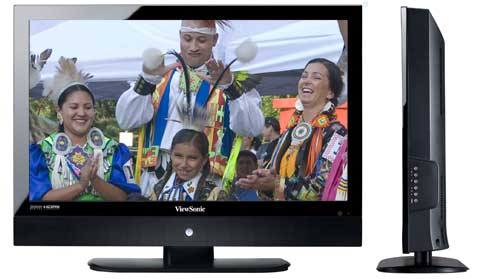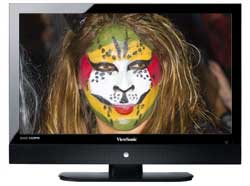
|
|
 |

|


|
ViewSonic N4285p Review
42" 1080p LCD HDTV
Out of the Box
This TV is one of those unassuming beauties that may not impress you until they smile and then Cupid's arrow twangs you right in the fanny. It doesn't turn you on until you turn it on. 
With a common two inch piano black bezel, the most distinguishing mark on the front of this 68 pound, 5.5 inch deep LCD is the the silver belly button, (the Power switch). Along the right edge are the rest of the TV controls. Now, for the techspeak housekeeping chore. On the back, the connection panel contains just two HDMI inputs, two Component (YPbPr) with matching stereo Audio Ins, two Composite (with Audio), one VGA (15 pin D-Sub) and an S-Video. If you are using a DVI to HDMI cable, you will also need to attach an audio cable. One of the HDMI inputs is matched with a stereo minijack Audio In, which is also the audio connection if you are hooking your laptop or PC up with a VGA cable. The other HDMI includes a companion set of L/R Stereo Ins. 
If you wish to run audio out of the TV into an A/V receiver, you can choose between the analog L/R Stereo Outs (RCA) or the SPDIF (optical) digital Audio Out. The one RF connector can take either an antenna or a cable signal and links to the internal NTSC/ATSC/QAM tuners. Since the tuner system is Clear QAM compatible, you can attach your cable TV signal directly into the RF connector and tune in unscrambled cable stations. There is no CableCARD slot. That's it for connectors - no third HDMI, no USB input, no Ethernet port. That also goes for picture-in-picture features - none. As I said, this is a simple, uncomplicated TV. Even the remote doesn't try to be fancy. It only controls the TV and I like that because the layout doesn't become cluttered with multi-function buttons that seem to do everything from turning on your DVD player to closing your garage door. Setup
Calibrating the TV was a breeze, partly because ViewSonic only provides the basic adjustments, Brightness, Contrast, Color, Tint, Sharpness and Color Temperature. Once again, there are no extra features like Contrast Enhancers, Gamma, or White Balance to fiddle with. Most importantly, the controls that are available allowed me to dial in a highly acceptable picture quickly. The only hiccup in the process was a battle that my eye was having with the test patterns. 
When I was adjusting Tint, two separate tests told me to move the Tint slider to around -10. But that made everything way too red. Ultimately, the default settings were almost right on for my tastes. Though if you have read my other reviews, you won't be surprised that I desaturated the image a few notches on the Color setting. And of course in the Color Temperature menu, I nudged the Red slider to bring skin tones down from the high blood pressure zone. |
Bookmark:
![]() del.icio.us
del.icio.us
![]() Reddit
Reddit
![]() Google
Google
| Send this Page | Print this Page | Report Errors |

